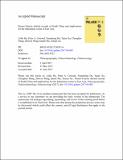Permo-Triassic detrital records of South China and implications for the Indosinian events in East Asia
Abstract
Provenance analyses of Lower to Middle Triassic strata from the Greater Youjiang Basin along with the Permian strata of Hainan Island, provide a record of the collisional assembly of the South China Craton and Indochina Block and their incorporation into Asia. Detrital zircons from Lower and Middle Triassic samples show similar overall age spectra ranging from Archean to Triassic with major age groups at 300–250 Ma, 480–420 Ma, and 1200–900 Ma, as well as at 400–300 Ma in one Triassic sample. Permian siltstones from Hainan Island, to the southeast of the Greater Youjiang Basin, record different age spectra with major age groups at 400–300 Ma and 530–420 Ma and subordinate components at 1200–900 Ma and 1900–1700 Ma. These age data in combination with available paleocurrent data and regional geological relations suggest that Precambrian detrital zircons were derived from the Precambrian basement or recycled from the overlying early Paleozoic sedimentary rocks that contain Precambrian detritus. Early Paleozoic detrital zircons were derived from igneous rocks in the South China Craton. Devonian-Triassic detrital zircons in the Triassic strata were likely sourced from coeval magmatic activity related to closure of Paleo-Tethys branch ocean that lay to the southwest, whereas 400–300 Ma detrital zircons in the Permian siltstones of Hainan Island were likely derived from a Paleozoic magmatic arc source that extended along the eastern-southeastern margin of China from Hainan Island to Japan in response to subduction of the Paleo-Pacific oceanic crust. Detrital zircon, trace element, and sandstone modal data for Permo-Triassic strata from the Greater Youjiang Basin indicate that the basin evolved from a trailing-edge passive margin setting to a peripheral foreland basin during closure of the Paleo-Tethys Ocean and collision between Indochina and South China. The initiation time of the foreland basin decreases from southeast to southwest across the basin, probably reflecting oblique collision. In contrast, the Permian strata on Hainan Island record a provenance history distinct from the Greater Youjiang Basin, which is related to late Paleozoic to Mesozoic subduction of the Paleo-Pacific Plate beneath South China.
Citation
Hu , L , Cawood , P A , Du , Y , Xu , Y , Wang , C , Wang , Z , Ma , Q & Xu , X 2017 , ' Permo-Triassic detrital records of South China and implications for the Indosinian events in East Asia ' , Palaeogeography, Palaeoclimatology, Palaeoecology , vol. 485 , pp. 84-100 . https://doi.org/10.1016/j.palaeo.2017.06.005
Publication
Palaeogeography, Palaeoclimatology, Palaeoecology
Status
Peer reviewed
ISSN
0031-0182Type
Journal article
Description
This work was supported by the National Natural Science Foundation of China (Grant No. 41602105, 41672106 and 41530966) and China Postdoctoral Science Foundation (Grant No. 2016M590655), the Fundamental Research Funds for the Central Universities, Ocean University of China. Peter Cawood acknowledges support from the Australian Research Council grant FL160100168.Collections
Items in the St Andrews Research Repository are protected by copyright, with all rights reserved, unless otherwise indicated.

